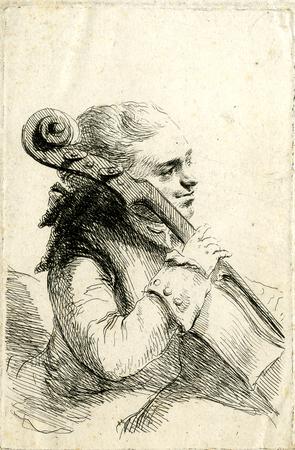
Jean-Pierre Duport, cellist and composer – print made by Baron Dominique Vivant Denon
Sonata no.2 for piano and cello in G minor Op.5/2 (1796, Beethoven aged 25)
Dedication Friedrich Wilhelm II, King of Prussia
Duration 27′
Listen
Background and Critical Reception
Beethoven and Jean-Louis Duport are thought to have performed both Op.5 sonatas for piano and cello at the court of King Frederick William II between 20 May and 3 July 1796 in Berlin. Nothing is known of the performances themselves, which are thought to have been private affairs – though the cellist’s brother, Jean-Pierre (above) would almost certainly have been in attendance.
The second of Beethoven’s ‘duo for a new duo’ is a very different work to its partner, and yet, as Marc D. Moskovitz and R. Larry Todd write in their superb book Beethoven’s Cello, ‘one could hardly imagine one without the other’.
Here we find Beethoven working in the key of G minor for the first time in his published output, a tonality to which he would hardly return across his entire output. He marks the occasion with a language we have not heard in his chamber music before. For, as Steven Isserlis writes in his booklet notes for Hyperion, the work ‘takes us firmly into the opera house’. He notes the theatrical aspects of the music throughout, from the grand introduction – ‘practically a full movement in its own right’ where ‘the lengthy silences seem to hover over a chasm of darkness’. This leads to a full-blown Allegro, described as ‘the most explosive (and surely the longest) movement of any duo sonata written up till that time’. The finale is a different beast, its protagonists off the leash and cavorting around the stage. Isserlis tells of how ‘He plays with the listener, reprising every possible section almost to the point of eye-rolling (was he being paid by the minute?!)’
Despite their chalk and cheese nature there are qualities common to both Op.5 works. Beethoven does not use a slow movement in either, meaning the only truly slow music we hear is towards the start of each piece. He uses quick, showy third movements, carefree and fast, wrapping up each of the pieces with memorable tunes.
Moskovitz and Todd declare that by the end of Beethoven’s two Op.5 sonatas, he had ‘single-handedly altered the history of the instrument, and changed forever how composers viewed and exploited its potential. Beethoven had written music fit for a king, but in the process created works that ennobled the composer’s art.’
Thoughts
The G minor sonata is a remarkable work, an ideal counterpart to its high spirited companion. There is a lot more shade in Beethoven’s writing here, perhaps inevitably given his choice of a minor key, but as Steven Isserlis says there is a great deal of authentic theatricality.
The introduction is truly dramatic, the piano pacing around impatiently as the cello leads with profound musical statements. Then the music settles on a ‘pedal’ note which gets increasingly tense, waiting to break out into the Allegro.
Once this part of the work begins, the listener is propelled forward towards Brahms in the way the cello and piano interact, using melodies ripe for expansive development. Passionate exchanges follow, a wholly absorbing set of musical ideas. Sometimes the cello is shadowed by the inner parts of the piano; at other times the keyboard is allowed to run free in a display of virtuosity, but Beethoven writes a taut musical argument which is wholly engaging.
The finale trips along in the major key, sporting lighter thematic ideas. Beethoven is out to have fun, but here he is looking forward again. This music sounds very similar in content to the finale of a much later piece, the Piano Concerto no.4 – also in G major. How versatile Beethoven’s thoughts were to become!
Recordings used and Spotify playlist
Steven Isserlis (cello), Robert Levin (fortepiano) (Hyperion)
Heinrich Schiff (cello), Till Fellner (piano) (Philips)
Miklós Perenyi (cello), András Schiff (piano) (ECM)
Mstislav Rostropovich (cello), Sviatoslav Richter (piano) (Decca)
Pierre Fournier (cello), Wilhelm Kempff (piano) (DG)
As with Op.5/1, the playlist below contains a handful of recordings of the piece, including Mstislav Rostropovich and Sviatoslav Richter, Heinrich Schiff and Till Felner. Miklós Perenyi and András Schiff and Pierre Fournier and Wilhelm Kempff. Fournier and Kempff give a passionate performance, Perenyi and Schiff live closer to the edge – but as with Op.5/1 I return to fortepianist Robert Levin and cellist Steven Isserlis, their reading jumping off the page as it alternates between power and affectionate tenderness.
The below playlist includes most of the recordings mentioned above save Isserlis and Levin – to hear clips from this you can visit the Hyperion website
You can chart the Arcana Beethoven playlist as it grows, with one recommended version of each piece we listen to. Catch up here!
Also written in 1796 Haydn – B-flat major, Hob.XXII:10
Next up Abschiedsgesang an Wiens Bürger

